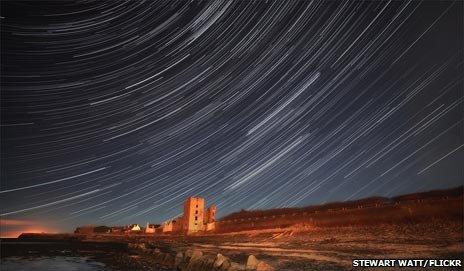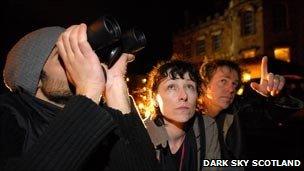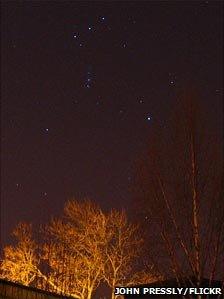Stargazing and dark sky tourism
- Published

A starry, starry night at the northern tip of Scotland
It's cold and dark - and the best time of year for stargazing. When dusk falls, step outside and look up. Star tourism is free - and areas with little light pollution hope to cash in.
The moon is but a sliver. The nights are long. A partial eclipse of the Sun is due. The Quadrantid meteor shower will be visible to the naked eye. And Jupiter, Uranus and Saturn are all closer than usual.
Little wonder this is an ideal time to look to the heavens.
While light pollution means those in towns and cities have restricted views, many have spent the festive break in more remote parts - and may have been struck by just how many stars prick across the night sky.
No telescope? No problem - experts say it's best to start with a full view of the night sky. These sights will be explored in BBC Two's Stargazing Live this week, timed to coincide with the meteor shower and partial eclipse.
While some visitors briefly marvel at the celestial show, increasing numbers choose their destination with stargazing in mind. Dark sky tourism is a small, but growing, trend.
"When people come on holiday to Scotland, they're often looking for the wilderness," says Dan Hillier, of the Royal Observatory Edinburgh and Dark Sky Scotland.
"They may not think the sky is part of that, but once they get there, they're often struck by how big and dark the sky is."
But how dark does a night sky have to be to get a good view?
"When you can see the Milky Way, that's a good definition of having a dark sky," says Mr Hillier. The Milky Way appears as a broad string of stars across the sky.

Satellite image showing Europe's light pollution 1993-2003
Dark sky maps are satellite images taken at night, and show light pollution spilling from towns and cities. The darkest areas on such a map are the best for stargazing. But urbanites can still stargaze on home turf, says Mr Hillier, if they pick their location carefully.
He suggests parks and school grounds, as these tend to be away from street lights and tall buildings, and so give a clearer view of the night sky.
Sky at night
Interest in the night sky has spiked since 2009's International Year of Astronomy. One of the surprise toy hits this Christmas was a mini telescope, with John Lewis reporting a 148% rise in sales.
Also in 2009, Galloway Forest Park was named the UK's first Dark Sky Park, an award set up by the International Dark Sky Association (IDA) to help reduce light pollution.
Since then, the type of stargazers coming to the area has changed, says Mike Alexande of the Galloway Astronomy Centre, a specialist stargazing B&B nearby.
"Through 2010, we have seen a jump in the business by 25 to 30%, specifically because of the Dark Sky Park. Up to this point, the vast majority of people had a very definite interest in astronomy. The extra visitors have come to see what all the fuss is about, but also because they have seen a dark sky on holiday and want to repeat the experience in the UK."
The majority come from the Home Counties - southern England's skies carry the sulphuric stain of light pollution.
But stars alone cannot carry a tourism boom.
"There has to be more to the location. But a dark sky can be used as an asset just like beautiful scenery," says Mr Alexande.
Stargazers need food, water, a bed for the night and toilet facilities. For this reason, national parks, with their established visitor facilities, are starting to make a virtue of their own dark skies.
Exmoor National Park aims to become an International Dark Sky Reserve - another IDA award. In recent research by the Campaign for Dark Skies into the best places in the UK for stargazing, external, taking into account light pollution and cloud cover, Exmoor came out as one of the best places to stargaze - even with the naked eye.

No special equipment needed
"You don't have to be an expert astronomer with technical equipment to appreciate a view of the stars," says landscape officer Emma Dennis.
People who visit national parks in the daytime - families, nature-lovers, ramblers, outdoor sport enthusiasts - tend to have at least a passing interest in the night sky, says Allan Trow, of Dark Sky Wales, who works with the Brecon Beacons National Park.
"It is these people we want to entice into staying up a little longer in order to view the sky."
To sow seeds of interest, Dark Sky Wales helps local businesses make the most of the area's night skies, visits schools with a mobile planetarium, and runs sidewalk astronomy sessions throughout Wales. Some 15,000 people took part in these sessions in the past year.
"We just roll up with a telescope or two and allow the public to look through them at the moon, planets or whatever they like."
'Scope it out
The burgeoning interest in astronomy is such that observatories open to the public are finally on the cards for rural areas.

Orion's belt - three bright stars, top - make this constellation easy to spot
And, thanks to the internet, schools, astronomers and amateur stargazers can book slots with telescopes for hire around the world.
"At the other end of the scale - simply looking up - that you can do anywhere," says Dan Hillier.
Particularly easy to spot in the UK's winter skies is Orion, a constellation also known as the Hunter, thanks to three bright stars in a row which form Orion's "belt", says astronomer Mark Thompson, who has put together audio star guides and tips for beginners.
"To find Orion, face south. The belt stars are distinctive, but if you need additional help, the line they make is a bit longer than the apparent width of your thumb when held up at arm's length.
"Allow your eyes at least 15 minutes to get used to the dark. You'll be amazed at how much more you can see."
Fingers crossed for clear skies.